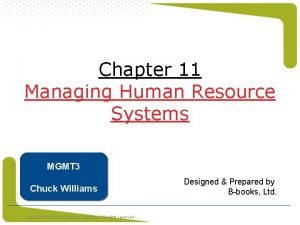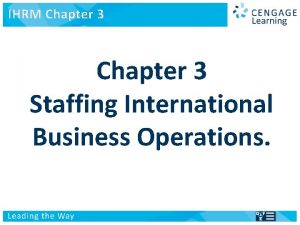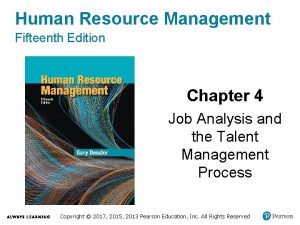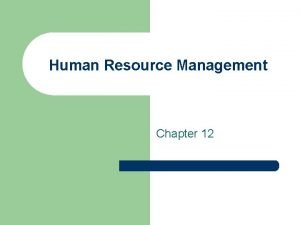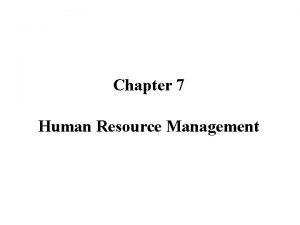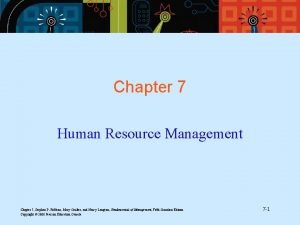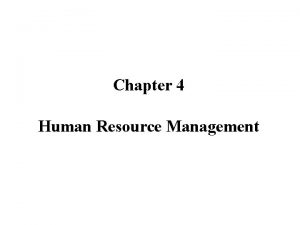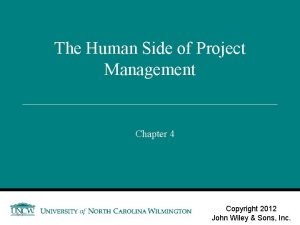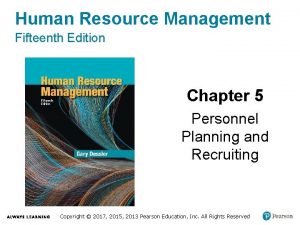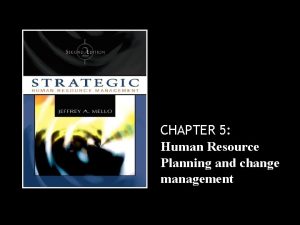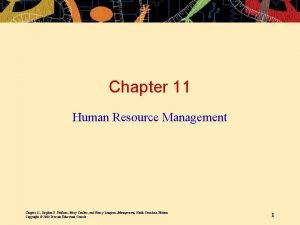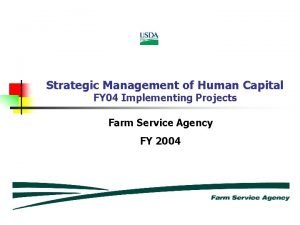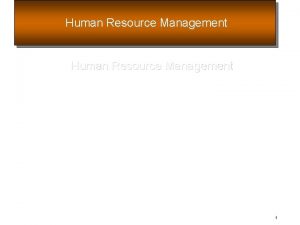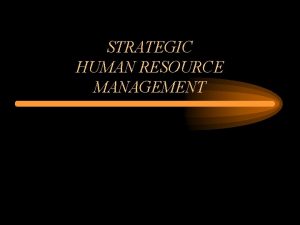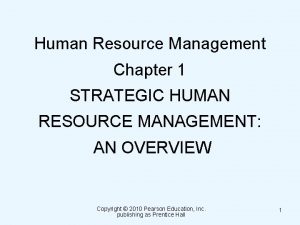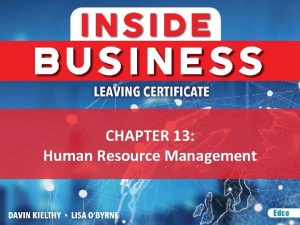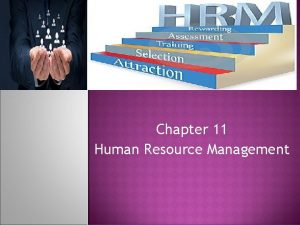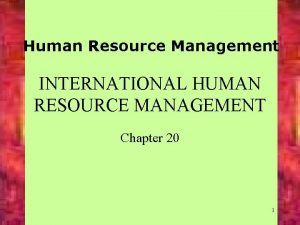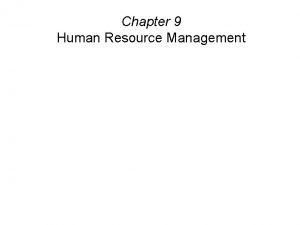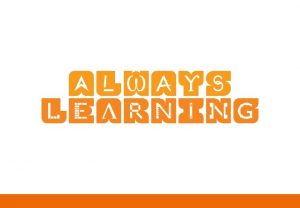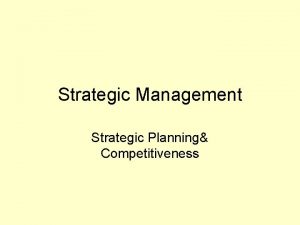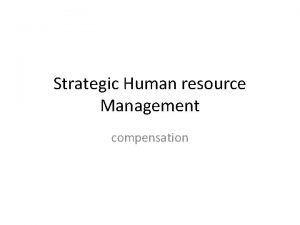Chapter 12 Human Resource Management Strategic Human Resource























- Slides: 23

Chapter 12 Human Resource Management

Strategic Human Resource Management n. Human Resource Management (HRM) – Activities that managers engage in to attract and retain employees and to ensure that they perform at a high level and contribute to the accomplishment of organizational goals. MGMT 321 – Chapter 12

Strategic Human Resource Management n Designing the components of a HRM system to be consistent with: – Each other – Other elements of organizational architecture – The organization’s strategy and goals n “Six Sigma” – Ensure that products and services are as free of errors or defects as possible through a variety of human resource-related initiatives MGMT 321 – Chapter 12

Components of a Human Resource Management System MGMT 321 – Chapter 12

The Legal Environment of HRM n Equal Employment Opportunity (EEO) – The equal right of all citizens to the opportunity to obtain employment regardless of their gender, age, race, country of origin, religion, or disabilities. – Equal Employment Opportunity Commission (EEOC) enforces employment laws. MGMT 321 – Chapter 12

The Legal Environment of HRM n Contemporary challenges for managers – How to eliminate sexual harassment – How to make accommodations for employees with disabilities – How to deal with employees who have substance abuse problems – How to manage HIV-positive employees and employees with AIDs MGMT 321 – Chapter 12

The Recruitment and Selection System MGMT 321 – Chapter 12

Human Resource Planning n Human Resource Planning (HRP) – Forecasting current and future human resourced needs. n Demand forecasts n Supply forecasts n Outsourcing – Loss of control over output – Unions are against outsourcing MGMT 321 – Chapter 12

Job Analysis n Job Analysis – Identifying the TDRs that make up a job and the KSAs needed to perform the job. – Should be done for each job n Methods – Observing what current workers do. – Having workers and manages fill out questionnaires MGMT 321 – Chapter 12

Recruitment n External Recruiting – Looking outside the organization to fill open positions n Internal Recruiting – Managers turn to existing employees to fill open positions n Realistic Job Preview – Providing an honest assessment of the advantages and disadvantages of a job MGMT 321 – Chapter 12

Selection Tools MGMT 321 – Chapter 12

Reliability and Validity n Selection tools must be BOTH reliable and valid n Reliability – The degree to which the tool measures the same thing each time it is used n Validity – The degree to which the test measures what it is supposed to measure MGMT 321 – Chapter 12

Training and Development n Training – Teaching organizational members how to perform their current jobs – Helping them to acquire the knowledge and skills they need to be effective performers n Development – Building the KSAs of organizational members to enable them to take on new responsibilities MGMT 321 – Chapter 12

Training and Development MGMT 321 – Chapter 12

Performance Appraisal and Feedback n Performance Appraisal – Evaluating employees’ job performance and contributions to the organization n Performance Feedback – Sharing performance appraisal information with subordinates and planning for the future MGMT 321 – Chapter 12

Types of Performance Appraisal n Trait – Personal characteristics that are relevant to job performance n Behavior – The actual actions and behaviors exhibited on the job. n Results appraisals – Actual outcomes of work behaviors n Objective and Subjective appraisals MGMT 321 – Chapter 12

Who Appraises Performance? MGMT 321 – Chapter 12

Effective Feedback Tips n n n n Be specific Focus on correctable behaviors or outcomes Utilize a problem solving approach Express confidence in a subordinate’s ability to improve. Provide feedback both formally and informally Praise instances of high performance Avoid personal criticisms Agree to a timetable for improvements MGMT 321 – Chapter 12

Pay n Includes employees’ base salaries, pay raises, and bonuses n Determined by: – Characteristics of the organization and the job – Levels of performance n Pay level – The relative position of an organization’s incentives compared to similar firms MGMT 321 – Chapter 12

Pay n Pay Structure CEO – The arrangement of jobs into categories based on their relative importance to the organization and its goals, level of skills, and other characteristics. VP VP Director MGMT 321 – Chapter 12 VP Dept Manager

Benefits n Legally required – Social security – Workers’ compensation n Voluntary – Health insurance – Retirement n Cafeteria-style benefits plans – Allow employees to choose the best mix – Can be hard to manage MGMT 321 – Chapter 12

Labor Relations Ensuring effective working relationships with the labor unions that represent their employees n Laws regulating areas of employment n – Fair Labor Standards Act (1938) prohibits child labor, sets a minimum wage and maximum working hours. – Equal Pay Act (1963) – Work Place Safety (1970) OSHA mandates procedures for safe working conditions MGMT 321 – Chapter 12

Unions Represent workers’ interests to management n The power that management has over individuals creates the need for unions n Collective bargaining n – Negotiation between labor and management to resolve conflicts and disputes regarding: • Working hours and conditions • Wages and benefits • Job security MGMT 321 – Chapter 12
 Time management human resources
Time management human resources Organized retailing
Organized retailing Human resources defintion
Human resources defintion Strategic human resource
Strategic human resource Strategic competitiveness
Strategic competitiveness Cultural aspects of strategy choice
Cultural aspects of strategy choice Chapter 2 human resource management
Chapter 2 human resource management Chapter 9 human resource management
Chapter 9 human resource management Chapter 11 human resource management
Chapter 11 human resource management Human resource management chapter 1
Human resource management chapter 1 Intro to human resource management
Intro to human resource management Human resource management lecture chapter 1
Human resource management lecture chapter 1 Human resource management lecture chapter 1
Human resource management lecture chapter 1 Chapter 3 human resource management
Chapter 3 human resource management Human resource management chapter 4
Human resource management chapter 4 Function of hrm
Function of hrm Chapter 7 human resource management
Chapter 7 human resource management Chapter 7 human resource management
Chapter 7 human resource management Human resource management chapter 4
Human resource management chapter 4 Human resource management chapter 4
Human resource management chapter 4 Replacement chart example
Replacement chart example Human resource management chapter 5
Human resource management chapter 5 Chapter 11 human resource management
Chapter 11 human resource management Strategic management of human capital
Strategic management of human capital








